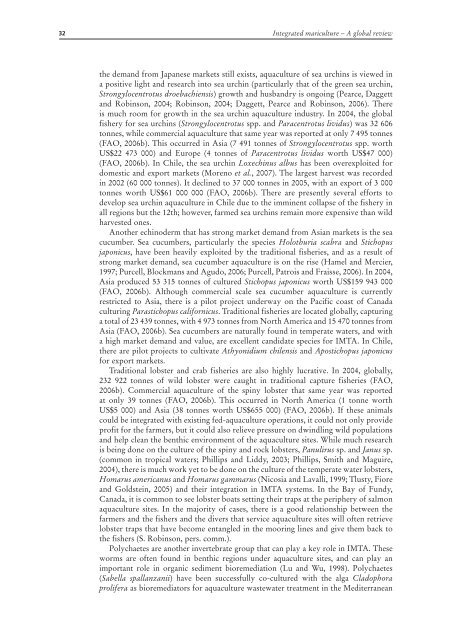Integrated multi-trophic aquaculture (IMTA) in marine temperate waters
Integrated multi-trophic aquaculture (IMTA) in marine temperate waters
Integrated multi-trophic aquaculture (IMTA) in marine temperate waters
You also want an ePaper? Increase the reach of your titles
YUMPU automatically turns print PDFs into web optimized ePapers that Google loves.
32<br />
<strong>Integrated</strong> mariculture – A global review<br />
the demand from Japanese markets still exists, <strong>aquaculture</strong> of sea urch<strong>in</strong>s is viewed <strong>in</strong><br />
a positive light and research <strong>in</strong>to sea urch<strong>in</strong> (particularly that of the green sea urch<strong>in</strong>,<br />
Strongylocentrotus droebachiensis) growth and husbandry is ongo<strong>in</strong>g (Pearce, Daggett<br />
and Rob<strong>in</strong>son, 2004; Rob<strong>in</strong>son, 2004; Daggett, Pearce and Rob<strong>in</strong>son, 2006). There<br />
is much room for growth <strong>in</strong> the sea urch<strong>in</strong> <strong>aquaculture</strong> <strong>in</strong>dustry. In 2004, the global<br />
fishery for sea urch<strong>in</strong>s (Strongylocentrotus spp. and Paracentrotus lividus) was 32 606<br />
tonnes, while commercial <strong>aquaculture</strong> that same year was reported at only 7 495 tonnes<br />
(FAO, 2006b). This occurred <strong>in</strong> Asia (7 491 tonnes of Strongylocentrotus spp. worth<br />
US$22 473 000) and Europe (4 tonnes of Paracentrotus lividus worth US$47 000)<br />
(FAO, 2006b). In Chile, the sea urch<strong>in</strong> Loxech<strong>in</strong>us albus has been overexploited for<br />
domestic and export markets (Moreno et al., 2007). The largest harvest was recorded<br />
<strong>in</strong> 2002 (60 000 tonnes). It decl<strong>in</strong>ed to 37 000 tonnes <strong>in</strong> 2005, with an export of 3 000<br />
tonnes worth US$61 000 000 (FAO, 2006b). There are presently several efforts to<br />
develop sea urch<strong>in</strong> <strong>aquaculture</strong> <strong>in</strong> Chile due to the imm<strong>in</strong>ent collapse of the fishery <strong>in</strong><br />
all regions but the 12th; however, farmed sea urch<strong>in</strong>s rema<strong>in</strong> more expensive than wild<br />
harvested ones.<br />
Another ech<strong>in</strong>oderm that has strong market demand from Asian markets is the sea<br />
cucumber. Sea cucumbers, particularly the species Holothuria scabra and Stichopus<br />
japonicus, have been heavily exploited by the traditional fisheries, and as a result of<br />
strong market demand, sea cucumber <strong>aquaculture</strong> is on the rise (Hamel and Mercier,<br />
1997; Purcell, Blockmans and Agudo, 2006; Purcell, Patrois and Fraisse, 2006). In 2004,<br />
Asia produced 53 315 tonnes of cultured Stichopus japonicus worth US$159 943 000<br />
(FAO, 2006b). Although commercial scale sea cucumber <strong>aquaculture</strong> is currently<br />
restricted to Asia, there is a pilot project underway on the Pacific coast of Canada<br />
cultur<strong>in</strong>g Parastichopus californicus. Traditional fisheries are located globally, captur<strong>in</strong>g<br />
a total of 23 439 tonnes, with 4 973 tonnes from North America and 15 470 tonnes from<br />
Asia (FAO, 2006b). Sea cucumbers are naturally found <strong>in</strong> <strong>temperate</strong> <strong>waters</strong>, and with<br />
a high market demand and value, are excellent candidate species for <strong>IMTA</strong>. In Chile,<br />
there are pilot projects to cultivate Athyonidium chilensis and Apostichopus japonicus<br />
for export markets.<br />
Traditional lobster and crab fisheries are also highly lucrative. In 2004, globally,<br />
232 922 tonnes of wild lobster were caught <strong>in</strong> traditional capture fisheries (FAO,<br />
2006b). Commercial <strong>aquaculture</strong> of the sp<strong>in</strong>y lobster that same year was reported<br />
at only 39 tonnes (FAO, 2006b). This occurred <strong>in</strong> North America (1 tonne worth<br />
US$5 000) and Asia (38 tonnes worth US$655 000) (FAO, 2006b). If these animals<br />
could be <strong>in</strong>tegrated with exist<strong>in</strong>g fed-<strong>aquaculture</strong> operations, it could not only provide<br />
profit for the farmers, but it could also relieve pressure on dw<strong>in</strong>dl<strong>in</strong>g wild populations<br />
and help clean the benthic environment of the <strong>aquaculture</strong> sites. While much research<br />
is be<strong>in</strong>g done on the culture of the sp<strong>in</strong>y and rock lobsters, Panulirus sp. and Janus sp.<br />
(common <strong>in</strong> tropical <strong>waters</strong>; Phillips and Liddy, 2003; Phillips, Smith and Maguire,<br />
2004), there is much work yet to be done on the culture of the <strong>temperate</strong> water lobsters,<br />
Homarus americanus and Homarus gammarus (Nicosia and Lavalli, 1999; Tlusty, Fiore<br />
and Goldste<strong>in</strong>, 2005) and their <strong>in</strong>tegration <strong>in</strong> <strong>IMTA</strong> systems. In the Bay of Fundy,<br />
Canada, it is common to see lobster boats sett<strong>in</strong>g their traps at the periphery of salmon<br />
<strong>aquaculture</strong> sites. In the majority of cases, there is a good relationship between the<br />
farmers and the fishers and the divers that service <strong>aquaculture</strong> sites will often retrieve<br />
lobster traps that have become entangled <strong>in</strong> the moor<strong>in</strong>g l<strong>in</strong>es and give them back to<br />
the fishers (S. Rob<strong>in</strong>son, pers. comm.).<br />
Polychaetes are another <strong>in</strong>vertebrate group that can play a key role <strong>in</strong> <strong>IMTA</strong>. These<br />
worms are often found <strong>in</strong> benthic regions under <strong>aquaculture</strong> sites, and can play an<br />
important role <strong>in</strong> organic sediment bioremediation (Lu and Wu, 1998). Polychaetes<br />
(Sabella spallanzanii) have been successfully co-cultured with the alga Cladophora<br />
prolifera as bioremediators for <strong>aquaculture</strong> wastewater treatment <strong>in</strong> the Mediterranean



